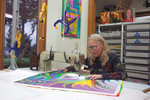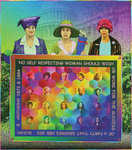Local audiences have from now through the end of February to check out Port Townsend artist Caryl Bryer Fallert-Gentry’s quilt commemorating women’s suffrage, entitled “First …
This item is available in full to subscribers.
We have recently launched a new and improved website. To continue reading, you will need to either log into your subscriber account, or purchase a new subscription.
If you had an active account on our previous website, then you have an account here. Simply reset your password to regain access to your account.
If you did not have an account on our previous website, but are a current print subscriber, click here to set up your website account.
Otherwise, click here to view your options for subscribing.
* Having trouble? Call our circulation department at 360-385-2900, or email our support.
Please log in to continue |
|


Local audiences have from now through the end of February to check out Port Townsend artist Caryl Bryer Fallert-Gentry’s quilt commemorating women’s suffrage, entitled “First Ladies,” at the Jefferson Museum of Art and History.
“It’s a really special piece that will travel all over the country, from now through 2022, and we’re the first to display it as part of that tour,” said Shelly Leavens, executive director of the Jefferson County Historical Society, who added that the quilt will go to the National Quilt Museum in Kentucky next, in March.
Although Fallert-Gentry has been quilting since the 1970s, she’s a relative newcomer to Jefferson County, having moved to her current home and art studio in Port Townsend in 2014, one year after marrying Ron Gentry.
The origins of her women’s suffrage quilt date back to 2017, when American quilt artist, author and curator Sandra Sider invited Fallert-Gentry to take part in a quilt exhibition entitled “Deeds Not Words: The Power of Persistence,” celebrating the 100th anniversary of the 19th Amendment to the U.S. Constitution on Aug. 18, 1920, granting American women the right to vote.
“I’m not usually a political artist, but I liked the curator, and the other artists were ones whom I admired,” Fallert-Gentry said.
Driven by enthusiasm, but bereft of any initial ideas, Fallert-Gentry scanned through historic records until a Library of Congress photo from June 2, 1920, caught her eye, by showcasing officers of the National Woman’s Party, standing in front of their Washington headquarters, before embarking on a trip to the Republican Party convention in Chicago, and holding a banner which included a quote by Susan B. Anthony.
Because the three women holding the banner reminded Fallert-Gentry of quilters holding a quilt up to exhibit it, she focused on them, and utilized her combination of high-tech and handmade techniques to capture their likenesses, making colored-pencil drawings of the women while also loading the photo onto her computer and playing with design possibilities.
She then replaced the banner with a quilt design that was similar to the “Grandmother’s Flower Garden” pattern that was popular in the 1920s. Within those spaces she placed portraits of other women who had moved forward both women’s rights and human rights in general in the century since the 19th Amendment was ratified.
While her first pass at research yielded 20 portraits of women who had made such significant contributions, Fallert-Gentry realized that her quilt needed to be even more inclusive, when her husband suggested including Madeline Albright, the first female Secretary of State in United States history.
“There were lots of other women I would have liked to include,” Fallert-Gentry said. “I began doing more research on women who were the first of their gender or ethnicity to do things that were previously done only by men or people of other ethnicities.”
These pioneers inspired the quilt’s eventual name of “First Ladies.”
“I also wanted to include some women who might not have been the first at what they did, but who made significant contributions to moving forward the cause of human rights in their generations,” she added.
Those 162 names would also be featured on the quilt, along with the Anthony quote from the original banner, with a quilt-within-the-quilt that could be lifted to reveal the accomplishments that went along with those names.
By the summer of 2018, Fallert-Gentry had acquired a computer that allowed her to draw and paint her quilt art directly onto the computer screen, and she could experiment with color and shading to a far more subtle degree than she had in her previous printed quilts, so that the quilt as a whole could become a rainbow spectrum, to “represent our diversity.”
The images of the women are arranged in more-or-less chronological order, but the irony is that not every woman who appears on the quilt could be properly credited.
The woman on the left was identified only as Mrs. James Rector,” Fallert-Gentry said. “I tried very hard to find her first name, and failed. The fact that she’s identified only by her husband’s name is, of course, an indication of why we need the women’s movement.”
After Kentucky, the quilt is slated to travel to Massachusetts, Texas, California, Virginia, Indiana and Iowa, before returning to Washington state in LaConner by 2022.
Leavens noted the quilt’s display will kick off the Jefferson Museum of Art and History’s celebration of the centennial of women’s suffrage, which continues throughout 2020 with 10 First Friday lectures by women, and three solo art exhibitions by women.
In the meantime, Fallert-Gentry continues to work from home, which triples as a private gallery and an art studio, where she uses fabric she’s created herself, and is beginning to branch out into more political artwork.
“Two-thirds of my work is not objective,” Fallert-Gentry said. “Most of it is abstract. The women’s suffrage quilt was more pictorial than a lot of work I’ve done in the past.”
Nonetheless, she’s looking into doing quilts on global warming and pollution, perhaps focusing on the plight of local orca pods.
“Quilt-making is addictive,” Fallert-Gentry said. “I like the feel of it. I like the fabric and the texture. I want to create things that are spiritually uplifting.”